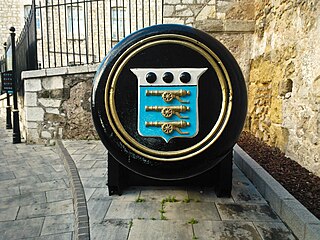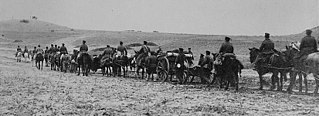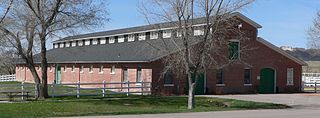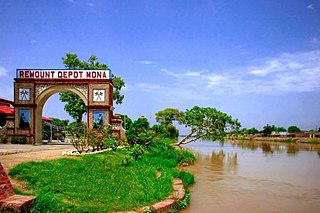| Army Remount Service | |
|---|---|
| Active | 1887–1942 |
| Country | United Kingdom |
| Branch | |
The Army Remount Service was the body responsible for the purchase and training of horses and mules as remounts for the British Army between 1887 and 1942.
| Army Remount Service | |
|---|---|
| Active | 1887–1942 |
| Country | United Kingdom |
| Branch | |
The Army Remount Service was the body responsible for the purchase and training of horses and mules as remounts for the British Army between 1887 and 1942.
Prior to 1887, the purchase of horses was the responsibility of individual regimental colonels, in the case of cavalry regiments, or of agents acting on behalf of the artillery and engineers. [1] This system worked well enough in peacetime but rapidly broke down during war when demand exceeded supply, prices rose and, the price that could be paid per horse being set by the Government, regimental purchasing officers and agents were frequently left with the most inferior animals. Consequently, in 1887 the Remount Department was set up in order to ensure the uniformity and suitability of the animals purchased for the army, and their training. Owners were encouraged to register a proportion of their horses with the Department, the Department having the option of purchasing these animals for a fixed sum in time of emergency. In recompense for this, the owners were paid a pension of 10/- per year for each animal.
In 1891, the service became part of the Army Service Corps (ASC) [2] and the majority of other ranks at remount depots were drawn from the ASC. [3]
Initially, there were three remount depots, the Remount Establishment at Woolwich (which provided horses for the Royal Artillery, Royal Engineers and Army Service Corps) and two in Dublin (for the cavalry), [4] with a total Army establishment of 12,500 horses and mules. The Boer War showed these arrangements to have been entirely inadequate (326,000 horses and 51,000 mules were lost, mainly through disease [5] ), so the animal establishment was increased to 25,000 and two additional depots were authorized, at Melton Mowbray, and Arborfield. In 1911, a further depot, the privately owned Pilckard's Farm in Chiddingfold near Godalming, was given to the War Office by its owners for a period of 21 years. [6] [7] [8] These depots provided total remount accommodation in the United Kingdom for some 1,200 animals. [9]
The Remount Service was only responsible for supplying horses and mules for use in Britain. Animals used by the Indian Army were entirely purchased by the Indian Government and those used by the British Army in the Middle East and elsewhere were bought by the local General Officer Commanding. [10]
The outbreak of war in 1914, therefore, found the British Army with a total establishment of 25,000 horses and mules, five Remount Depots and four Remount companies, with a remount strength of approximately 1,200 animals. [11] [12] Within 12 days, the establishment had been increased to 165,000 animals, entirely by impressment, and a year later, in August 1915, to 534,971. At its peak in 1917, the Army establishment reached almost 870,000 horses and mules, with remount accommodation for 60,000 animals. [13] To cope with this increase, four additional main Home depots were established, at Shirehampton, Romsey, Ormskirk and Swaythling, and the capacity and complement of each depot were also increased. At Swaythling, for example, on 1 April 1919 (several months after the end of the war), 3,530 horses and mules were stabled and cared for by 757 men. [14] The first three of these depots were used for horses and mules arriving from overseas, whilst Swaythling was a collection centre for animals being shipped abroad. Several other smaller depots were established throughout the country for receipt of locally bred horses.
The establishment of officers and men was also increased to cope with this number of animals, from 121 officers and 230 men in August 1914 to 423 officers and 20,560 men in 1917. [15] Many of the remount officers were drawn from the landed gentry, masters of fox hounds and others who had experience with horses in civilian life, thus avoiding withdrawing army officers from their normal duties. Such remount officers included the well known artists Alfred Munnings, Cecil Aldin, G. Denholm Armour and Lionel Edwards, and Scots-Australian poet Will H. Ogilvie.
A Base Remount Depot and two Advanced Remount Depots went to France with the British Expeditionary Force in 1914 and were subsequently supplemented by two further Base Remount Depots at the Channel Ports. At the peak of operations, these had an establishment of 16,000 to 17,000 animals. Depots were set up in Egypt and Salonika for the campaigns in those regions. Animals for these areas were originally obtained from Australia (horses) and North America (mules) although, owing to difficulties with transport, all animals were later supplied from Britain. The supply of animals for the Mesopotamian Campaign was undertaken by the Indian Government.
Over the course of the war, a total of 468,323 horses were purchased in the United Kingdom, 428,608 horses and 275,097 mules in North America, 6,000 horses and 1,500 mules came from South America, and 3,700 mules from Spain and Portugal. [16] Between 1914 and 1920, the Remount Service spent £67.5 million on the purchase and training of these animals. There was initial concern that the neutrality of the United States might prevent the purchase of animals in that country, but this proved not to be the case and remount purchasing delegations were set up in Kansas City, St Louis, Chicago, Fort Worth and Denver. [17] In addition to the British Army, the British Remount Service supplied animals to the Belgian, Canadian, Australian, New Zealand and Portuguese armies, and even the American Expeditionary Force. [18]
The mechanization of the British Army during the 1930s substantially reduced the Army's need for horses in the Second World War, although mules were still used as pack animals in rough terrain, particularly in Burma and Italy. However, the number of animals required was relatively small and in 1942 the Army Remount Service was amalgamated into the Army Veterinary and Remount Service. [19]
An Ammunition Column was a support echelon of a British or Dominion brigade or division during the First World War and consisted of dedicated military vehicles carrying artillery and small arms ammunition for the combatant unit to which the column belonged, generally an Artillery Brigade or a Divisional Artillery.

The Board of Ordnance was a British government body. Established in the Tudor period, it had its headquarters in the Tower of London. Its primary responsibilities were 'to act as custodian of the lands, depots and forts required for the defence of the realm and its overseas possessions, and as the supplier of munitions and equipment to both the Army and the Navy'. The Board also maintained and directed the Artillery and Engineer corps, which it founded in the 18th century. By the 19th century, the Board of Ordnance was second in size only to HM Treasury among government departments. The Board lasted until 1855, at which point it was disbanded.

The Royal Army Service Corps (RASC) was a corps of the British Army responsible for land, coastal and lake transport, air despatch, barracks administration, the Army Fire Service, staffing headquarters' units, supply of food, water, fuel and domestic materials such as clothing, furniture and stationery and the supply of technical and military equipment. In 1965 its functions were divided between other Corps and the RASC ceased to exist; subsequently, in 1993, they in their turn became the "Forming Corps" of the Royal Logistic Corps.

Woolwich Common is a common in Woolwich in southeast London, England. It is partly used as military land and partly as an urban park. Woolwich Common is a conservation area. It is part of the South East London Green Chain. It is also the name of a street on the east side of the common, as well as an electoral ward of the Royal Borough of Greenwich. The population of the ward at the 2011 Census was 17,499.

The Royal Army Veterinary Corps (RAVC), known as the Army Veterinary Corps (AVC) until it gained the royal prefix on 27 November 1918, is an administrative and operational branch of the British Army responsible for the provision, training and care of animals. They are also responsible for explosives and drug search dogs. It is a small corps, forming part of the Army Medical Services.

Swaythling is a suburb and electoral ward of the city of Southampton in Hampshire, England. The ward has a population of 13,664.

The Royal Army Ordnance Corps (RAOC) was a corps of the British Army. At its renaming as a Royal Corps in 1918 it was both a supply and repair corps. In the supply area it had responsibility for weapons, armoured vehicles and other military equipment, ammunition and clothing and certain minor functions such as laundry, mobile baths and photography. The RAOC was also responsible for a major element of the repair of Army equipment. In 1942 the latter function was transferred to the Royal Electrical and Mechanical Engineers (REME) and the vehicle storage and spares responsibilities of the Royal Army Service Corps were in turn passed over to the RAOC. The RAOC retained repair responsibilities for ammunition, clothing and certain ranges of general stores. In 1964 the McLeod Reorganisation of Army Logistics resulted in the RAOC absorbing petroleum, rations and accommodation stores functions from the Royal Army Service Corps as well as the Army Fire Service, barrack services, sponsorship of NAAFI (EFI) and the management of staff clerks from the same Corps. On 5 April 1993, the RAOC was one of the corps that amalgamated to form The Royal Logistic Corps (RLC).
When a World War I medal was issued to a member of Commonwealth forces, it was issued with a Service Number, Rank, Name and Regiment. This information should be on every medal that was issued during the First World War.

Lucy Elizabeth Kemp-Welch was a British artist and teacher who specialised in painting horses. Though increasingly overlooked after the Second World War, from the late 1890s to the mid-1920s she was one of the country's best-known female artists. As her obituary in The Times noted, 'Like most artists who came to maturity and were established before the end of the nineteenth century, Lucy Kemp-Welch suffered somewhat in her later reputation from the violent changes in art which followed. In her prime as an animal painter she held a position in this country comparable to that of Rosa Bonheur in France, and the only British woman artist of her generation who was more talked about was Lady Elizabeth Butler, painter of "The Roll Call".' Her reputation has since revived, and she is best known today for her large paintings of wild and working horses in the New Forest, and those in military service which she produced during the First World War, as well as for her illustrations to the 1915 edition of Anna Sewell's novel Black Beauty.

Arborfield Garrison was a British Army garrison, now the site of Arborfield Green, a new village approximately 1 mile (1.6 km) south east of the village of Arborfield Cross in the English county of Berkshire. The army vacated the site in 2015 and it is now being redeveloped for housing, with a total of 3,500 homes planned. The Garrison and its associated housing estates are split between the civil parishes of Arborfield and Newland and Barkham. Both parishes are within the unitary authority of Wokingham. According to the Post Office, the majority of the 2011 Census population was included in the civil parish of Barkham.

In military contexts, a train is the logistical transport elements accompanying a military force. Often called a supply train or baggage train, it has the job of providing materiel for their associated combat forces when in the field. When focused on provision of field artillery and its ammunition, it may be termed an artillery train. For sieges, the addition of siege engines to an artillery train was called a siege train. These military terms predate, and do not imply a railway train, though railways are often employed for modern logistics, and can include armoured trains.

The use of horses in World War I marked a transitional period in the evolution of armed conflict. Cavalry units were initially considered essential offensive elements of a military force, but over the course of the war, the vulnerability of horses to modern machine gun, mortar, and artillery fire reduced their utility on the battlefield. This paralleled the development of tanks, which ultimately replaced cavalry in shock tactics. While the perceived value of the horse in war changed dramatically, horses still played a significant role throughout the war.
The Egyptian Labour Corps was a group of Egyptian labourers who worked for the British Army in Egypt during the First World War's Sinai and Palestine Campaign.

A part of the Quartermaster Corps, the U.S. Army Remount Service provided horses as remounts to U.S. Army units. Evolving from both the Remount Service of the Quartermaster Corps and a general horse-breeding program under the control of the Department of Agriculture, the Remount Service began systematically breeding horses for the United States Cavalry in 1918. It remained in operation until 1948, when all animal-breeding programs returned to Department of Agriculture control.

Army Remount Depot Mona is a depot of the Pakistan Army situated in Mandi Bahauddin, Punjab, Pakistan. It was established in 1902 and is home to breeding grounds for horses, mules and donkeys. It was originally designed to supply mountain artillery mules and general service mules. Mona is a full member of the World Arabian Horse Organization (WAHO). It is the largest functional remount installation in the world and is spread over 10,000 acres.

The Australian Army Veterinary Corps (AAVC) was a corps of the Australian Army which was formed in 1909 to replace the veterinary department of the Commonwealth Military Forces. Following the establishment of a number of permanent artillery batteries and a remount department to supply them with horses, a permanent section of the AAVC was formed in 1911. Responsibilities included veterinary care of horses and the training of farriers and non-commissioned officers in shoeing, horse care and veterinary first aid. During the First World War 120 officers of the AAVC served overseas with the Australian Imperial Force. However, due to the effect of mechanisation there was only a limited role for specialised veterinary services during the Second World War. The corps was disbanded in 1946.

The Macedonian Mule Corps was a formation of the British Salonika Army consisting primarily of Cypriot muleteers and their mules. The unit was established in 1916 and dissolved in March 1919. During its service it provided crucial logistical support to the Allied war effort on the Macedonian front and the Southern Russia intervention. 12,288 Cypriots served in the corps, 3,000 of whom received bronze British War Medals.
Remount referred to the provision of fresh horses, particularly for military purposes. The word encompasses both the animals themselves and the means by which they were provided. In many cases, remounts were horses provided to replace those killed or injured in battle.

William Stansfield was a British-born Australian railway officer in the Queensland State Railways who joined the Australian Army and served in Gallipoli and the Middle East during the World War I.

James B. Aleshire was a career officer in the United States Army. A 1880 graduate of the United States Military Academy, he served from 1880 to 1916, and attained the rank of major general. A veteran of the American Indian Wars, Spanish–American War, China Relief Expedition, and Philippine–American War, Aleshire was most notable for his service as Quartermaster General of the United States Army from 1907 to 1916, during which he was credited with combining the formerly separate Quartermaster, Subsistence and Pay Departments to create the consolidated U.S. Army Quartermaster Corps.